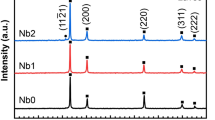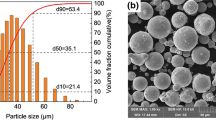Abstract
Zr and its alloys have excellent mechanical properties as new structural material, but in specific application environment, its corrosion resistance still needs to be further explored. In this work, double glow plasma surface alloying technique was used for copperizing on pure Zr surface. Besides, X-ray diffraction (XRD), scanning electron microscope (SEM) and energy dispersion spectrum (EDS) were employed to characterize the samples. Furthermore, research was also conducted on the polarization curve of the samples in different solutions. Copperizing on surface can improve corrosion resistance of pure Zr in 3.5 % NaCl and 0.5 mol·L−1 NaOH solutions. Especially in 0.5 mol·L−1 NaOH solution, the corrosion resistance can achieve significant improvement. However, copperizing has no influence on the improvement of corrosion resistance of pure Zr in 0.5 mol·L−1 H2SO4 solution. The results may provide new insight into way for improving the corrosion property of zirconium alloys.











Similar content being viewed by others
References
Feng ZH, Jiang XJ, Zhou YK, Xia CQ, Liang SX, Jing R, Zhang XY, Ma MZ, Liu RP. Influence of beryllium addition on the microstructural evolution and mechanical properties of Zr alloys. Mater Des. 2015;65:890.
Peng JQ, Yin YX, Wang X, Li JS, Wang LJ. Research status and progress in single crystal growth of zirconium, hafnium and their alloys. Chin J Rare Met. 2015;39(6):562.
Wei TG, Zhang L, Miao Z, Liu H, Luan BF, Wang W, Long CS. Microstructure and corrosion behavior of Zr–1.0Cr–0.4Fe–xMo alloys. Rare Met. 2015;34(2):118.
Hai MN, Wang KS, Wang W, Hao YX, Xu RQ, Li Y. Corrosion property of pure zirconium R60702 welded joint. Chin J Rare Met. 2015;39(9):787.
Tian HF, Qiao JW, Yang HJ, Wang YS, Liaw PK, Lan AD. The corrosion behavior of in situ Zr-based metallic glass matrix composites in different corrosive media. Appl Surf Sci. 2016;363:37.
Tang GY, Choi BH, Kim W, Jung KS, Kwon HS, Lee SJ, Lee JH, Song TY, Shon DH, Han JG. The characteristics of surface oxidation and corrosion resistance of nitrogen implanted zircaloy-4. Surf Coat Technol. 1997;89(3):252.
Xu J, Bai XD, He F, Wang SG, He XZ, Fan YD. Influence of Ar ion bombardment on the uniform corrosion resistance of laser-surface-melted zircaloy-4. J Nucl Mater. 1999;265(3):240.
Sandhyarani M, Rameshbadu N, Venkateswarlu K, Rama KL. Fabrication, characterization and in vitro evaluation of nanostructured zirconia/hydroxyapatite composite film on zirconium. Surf Coat Technol. 2014;238:58.
Yang JX, Wang X, Wen Q, Wang XB, Wang RS, Zhang YW, Xue WB. The effect of microarc oxidation and excimer laser processing on the microstructure and corrosion resistance of Zr–1Nb alloy. J Nucl Mater. 2015;467(1):186.
Xian G, Zhao HB, Fan HY, Du H. Structure and mechanical properties of Zr/TiAlN films prepared by plasma-enhanced magnetron sputtering. Rare Met. 2015;34(10):717.
Morgiel J, Wierzchoń T. New estimate of phase sequence in diffusive layer formed on plasma nitrided Ti–6Al–4V alloy. Surf Coat Technol. 2014;259:473.
Cassar G, Matthews A, Leyland A. Triode plasma diffusion treatment of titanium alloys. Surf Coat Technol. 2012;212:20.
Ren BL, Miao Q, Liang WP, Yao ZJ, Zhang PZ. Characteristics of Mo–Cr duplex-alloyed layer on Ti6Al4V by double glow plasma surface metallurgy. Surf Coat Technol. 2013;228(S1):S206.
Qiu ZK, Zhang PZ, Wei DB, Wei XF, Chen XH. A study on tribological behavior of double-glow plasma surface alloying W–Mo coating on gear steel. Surf Coat Technol. 2015;278:92.
Liu HB, Tao J, Xu J, Chen ZF, Gao Q. Corrosion and tribological behaviors of chromium oxide coatings prepared by the glow-discharge plasma technique. Surf Coat Technol. 2009;204(1–2):28.
Cassar G, Wilson AB, Banfield S, Housden J, Matthews A, Leyland A. Surface modification of Ti–6Al–4V alloys using triode plasma oxidation treatments. Surf Coat Technol. 2012;206(22):4553.
Qin L, Tian LH, Fan AL, Tang B, Xu Z. Fatigue behavior of surface modified Ti–6Al–4V alloy by double glow discharge plasma alloying. Surf Coat Technol. 2007;201(9–11):5282.
Chen ZF, Wu WP, Cong XN. Oxidation resistance coatings of Ir–Zr and Ir by double glow plasma. J Mater Sci Technol. 2014;30(3):268.
Luo XX, Yao ZJ, Zhang PZ, Miao Q, Liang WP, Wei DB, Chen Y. A study on high temperature oxidation behavior of double glow plasma surface metallurgy Fe–Al–Cr alloyed layer on Q235 steel. Appl Surf Sci. 2014;305:259.
Lin YB, Wang C, Tao J. Induction effect of α-Al2O3 seeds on formation of alumina coatings prepared by double glow plasma technique. Surf Coat Technol. 2013;235:544.
Jamesh MI, Li PH, Bilek MMM, Boxman RL, McKenzie DR, Chu PK. Evaluation of corrosion resistance and cytocompatibility of graded metal carbon film on Ti and NiTi prepared by hybrid cathodic arc/glow discharge plasma-assisted chemical vapor deposition. Corros Sci. 2015;97:126.
Wang Q, Zhang PZ, Wei DB, Wang RN, Chen XH, Wang HY. Microstructure and corrosion resistance of pure titanium surface modified by double-glow plasma surface alloying. Mater Des. 2013;49:1042.
Qiu ZK, Zhang PZ, Wei DB, Wei XF, Chen XH, Wang Y. Mechanical and electrochemical properties of Zr and Zr–Er alloyed layers deposited on titanium alloy (TC11). Surf Coat Technol. 2015;280:301.
Chakravartty JK, Dey GK, Banerjee S, Prasad YVRK. Characterization of hot deformation behaviour of Zr–2.5Nb–0.5Cu using processing maps. J Nucl Mater. 1995;218(2):247.
Yilmazbayhan A, Motta AT, Comstock RJ, Sabol GP, Lai B, Cai ZH. Structure of zirconium alloy oxides formed in pure water studied with synchrotron radiation and optical microscopy: relation to corrosion rate. J Nucl Mater. 2004;324(1):6.
Park JY, Choi BK, Yoo SJ, Jeong YH. Corrosion behavior and oxide properties of Zr–1.1 wt%Nb–0.05 wt%Cu alloy. J Nucl Mater. 2006;359(1–2):59.
Hong HS, Moon JS, Kim SJ, Lee KS. Investigation on the oxidation characteristics of copper-added modified zircaloy-4 alloys in pressurized water at 360 °C. J Nucl Mater. 2001;297(2):113.
Jeong YH, Park JY, Baek JH, Kim KT. Development of high corrosion resistant zirconium alloys (HANA). In: Proceedings of Behaviour of High Corrosion Resistance Zr-Based Alloys. Buenos Aires; 2005. 12.
Wei DB, Zhang PZ, Yao ZJ, Zhou JT, Wei XF, Chen XH. Double glow plasma chromizing of Ti6Al4V alloys: impact of working time, substrate-target distance, argon pressure and surface temperature of substrate. Vacuum. 2015;121:81.
Xu Z, Liu X, Zhang P, Zhang Y, Zhang G, He Z. Double glow plasma surface alloying and plasma nitriding. Surf Coat Technol. 2007;201(9–11):4822.
Peng JQ, Chen Y, Yan GQ, Wu M, Wang LJ, Li JS. Solid solubility extension and microstructure evolution of cast zirconium yttrium alloy. Rare Met. 2016;35(4):325.
Li Q, Liang X, Zhou BX, Yao MY, Peng JC. Existing form of Cu in Zr–2.5Nb–0.5Cu alloys and the oxide films during corrosion testing in SCW at 550 °C/25 MPa. Rare Mater Eng. 2012;41(1):92.
Uporov SA, Estemirova SKh, Chtchelkatchev NM, Ryltsev RE. Anomalous electrical conductivity in rapidly crystallized Cu100−x Zr x (x = 50–66.6) alloys. J Alloys Compd. 2015;647:397.
Wu DY, Song KK, Gargarella P, Cao CD, Li R, Kaban I, Eckert J. Glass-forming ability, thermal stability of B2 CuZr phase, and crystallization kinetics for rapidly solidified Cu–Zr–Zn alloys. J Alloys Compd. 2016;664:99.
Peng LJ, Mi XJ, Xiong BQ, Xie HF, Huang GJ. Microstructure of phases in a Cu–Zr alloy. Rare Met. 2015;34(10):706.
Acknowledgments
This study was financially supported by the National Basic Research Program of China (No. 2013CB733000) and the National Natural Science Foundation of China (Nos. 51271161, 51271162 and 51434008).
Author information
Authors and Affiliations
Corresponding author
Rights and permissions
About this article
Cite this article
Wang, JQ., Yang, HB., Zhang, B. et al. Corrosion property of copperized layer on Zr formed by double glow plasma surface alloying technique. Rare Met. 35, 711–717 (2016). https://doi.org/10.1007/s12598-016-0792-6
Received:
Revised:
Accepted:
Published:
Issue Date:
DOI: https://doi.org/10.1007/s12598-016-0792-6




